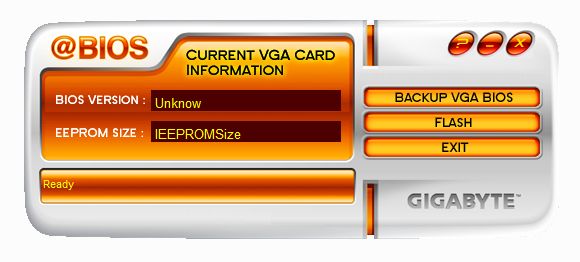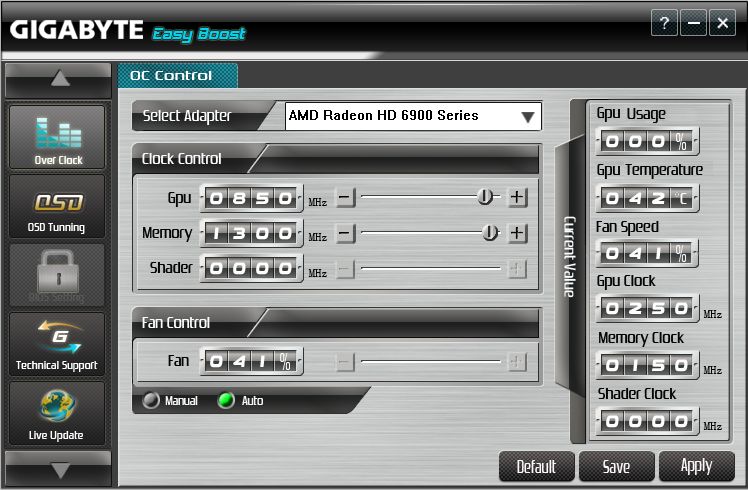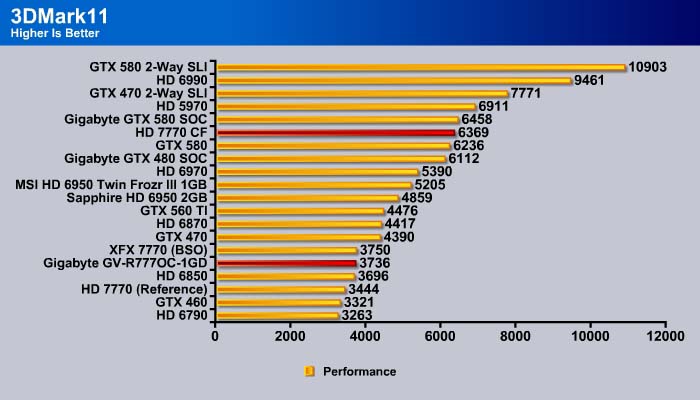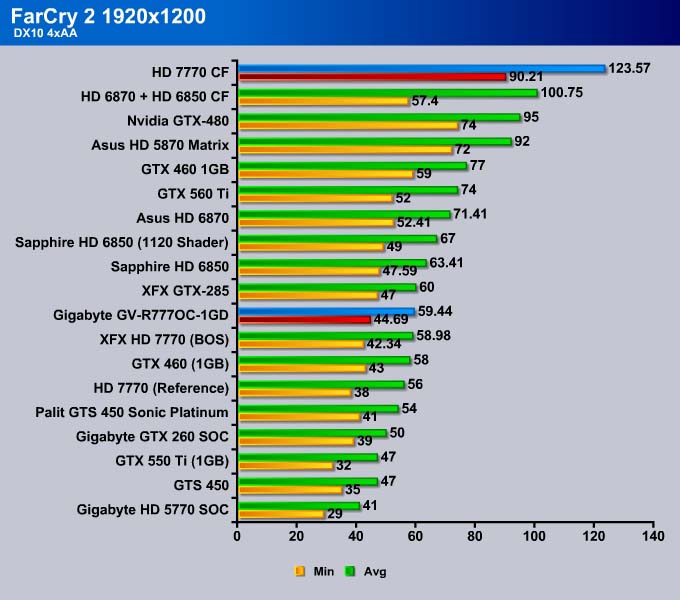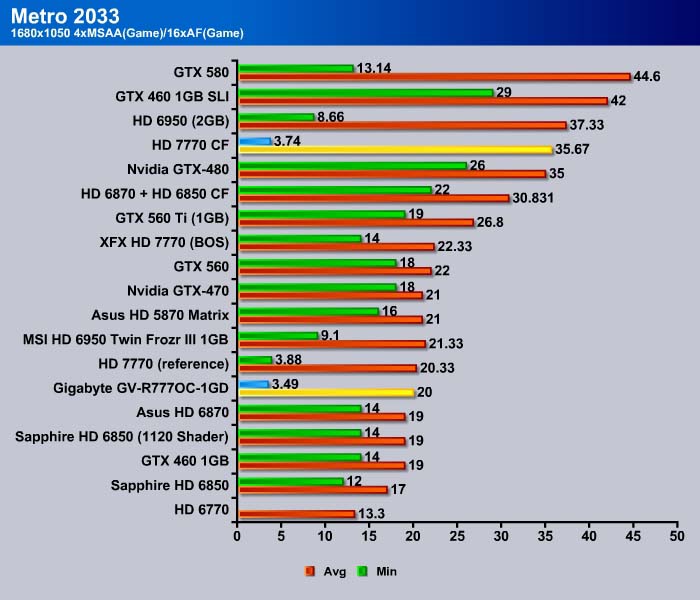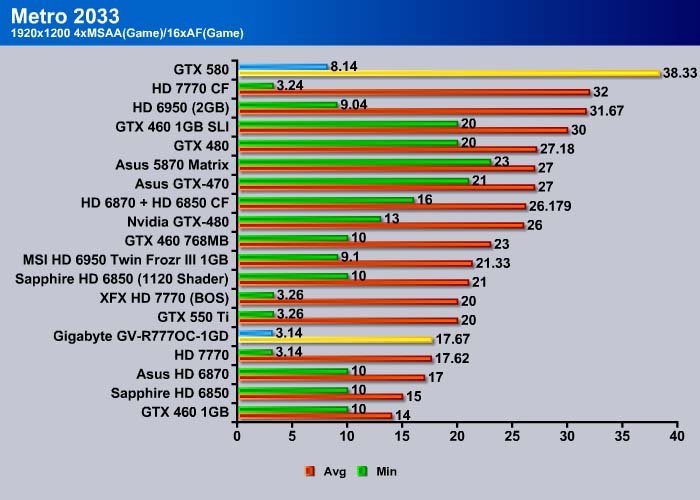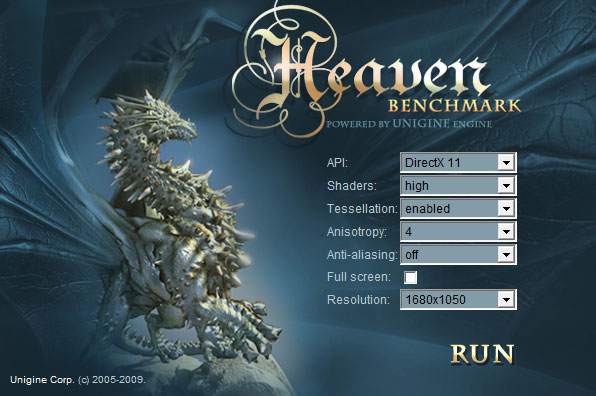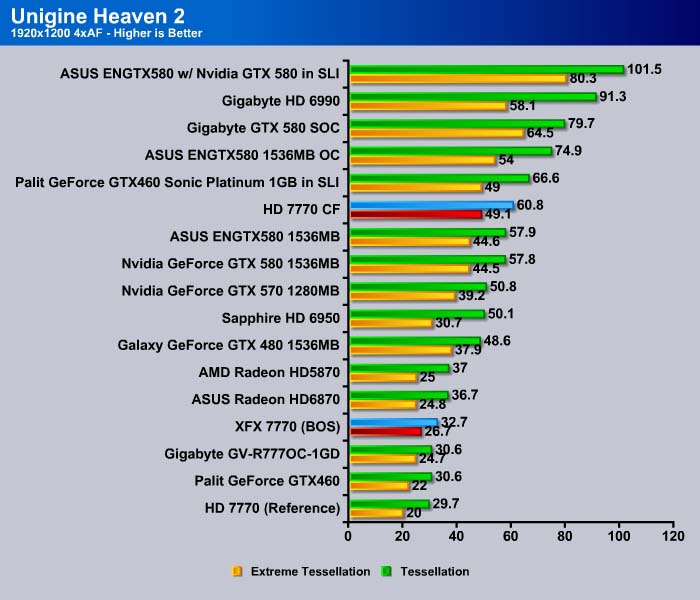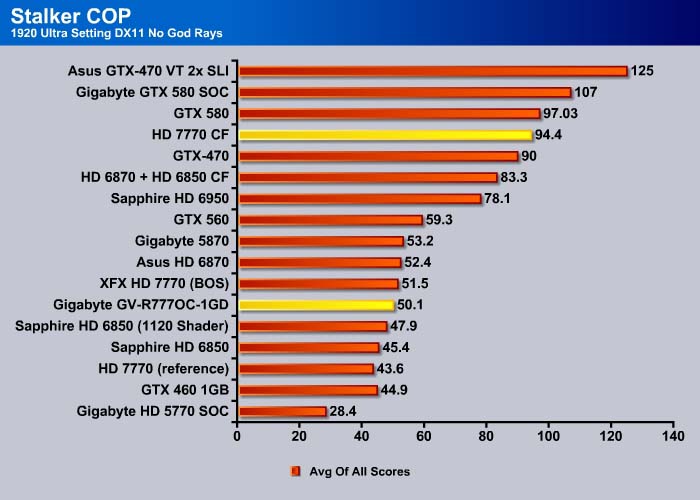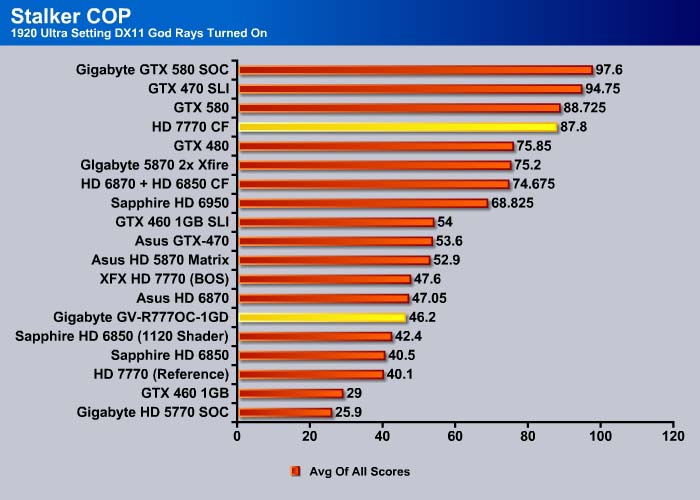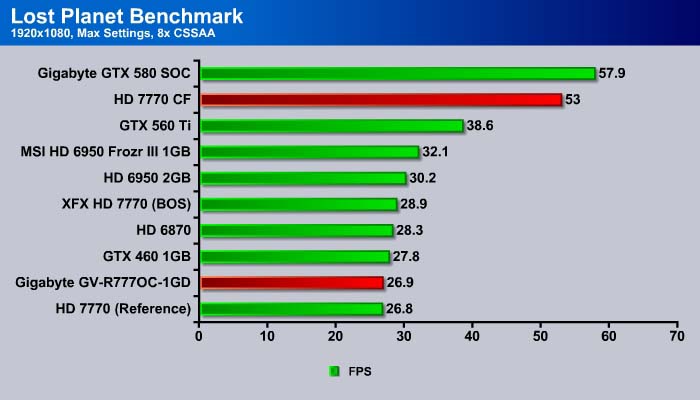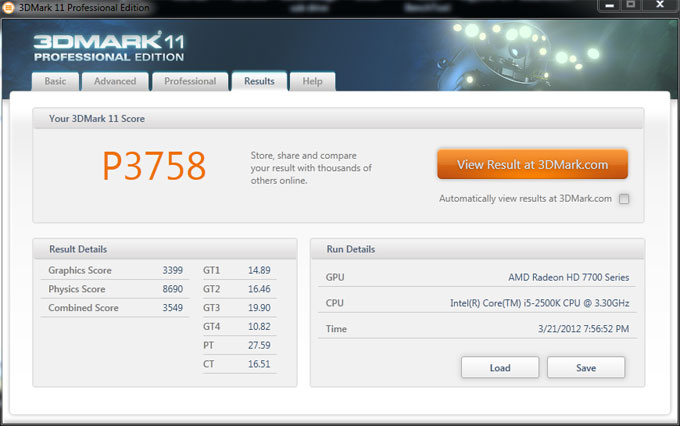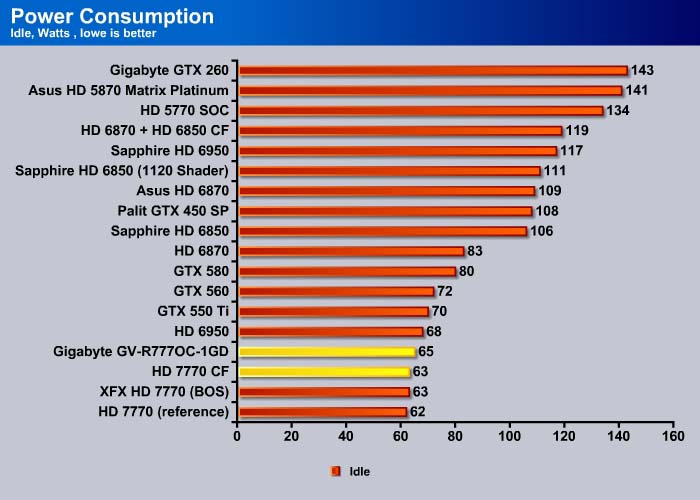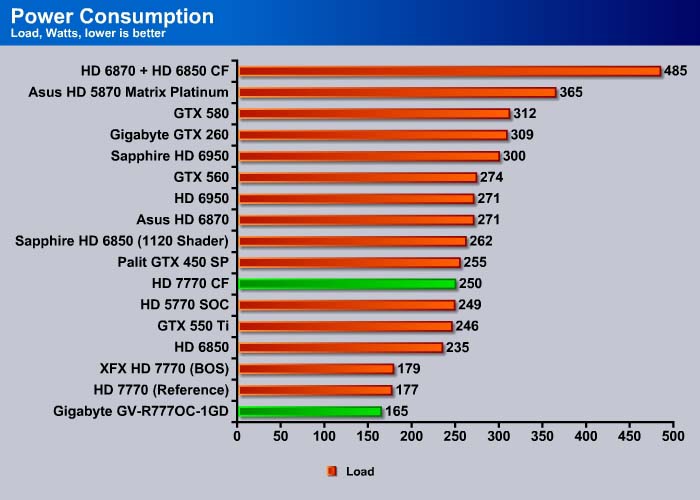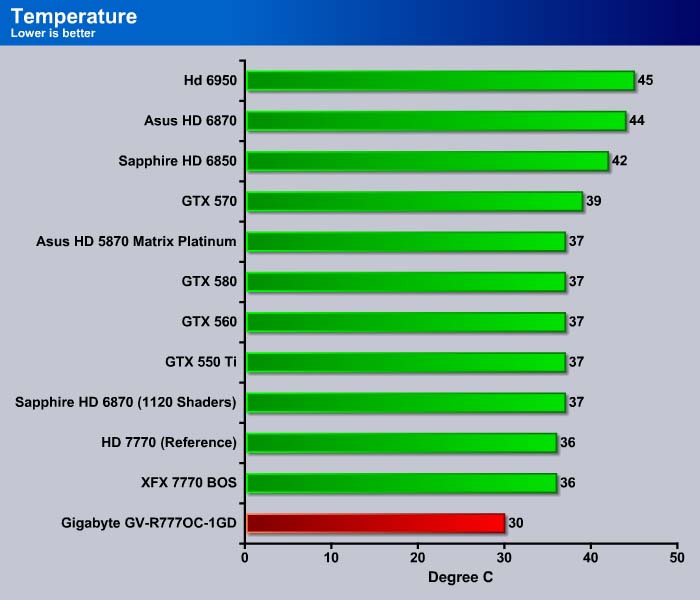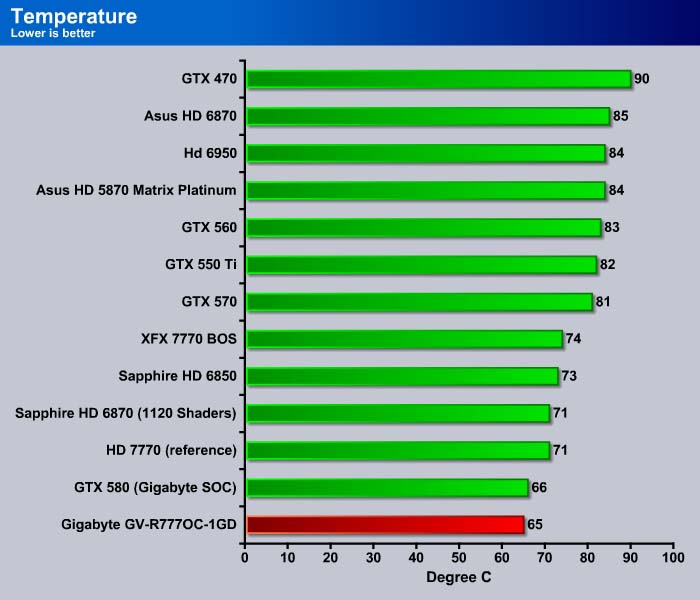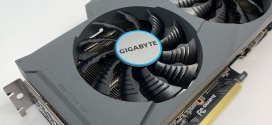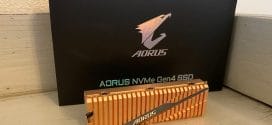Gigabyte’s HD 7770 OC is the cheapest factory overclocked HD 7770 available. It strikes a good balance of price and performance. We put the card to the test and also pair it up with XFX HD 7770 to assess its CrossFire performance.
INTRODUCTION
The AMD HD 7770 brings is mid-range graphics card that is power efficient and low operational noise. Unfortunately, the card does not always perform as well as the last generation of midrange card from AMD, the HD 6850, at the default clockspeed. The HD 7770 really needs to be overclocked and priced at similar price range as the HD 6850 to make it competitive enough to convince potential buyers from choosing the HD 6850 over the HD 7770.
Gigabyte has launched two HD 7770s. The GV-R777D5-1GB is the reference-clocked card, retailed at $149.99 and for extra $10 more, users can buy the factory overclocked GV-R77OC-1GB. This price differential is attractive to customers compared to the XFX R7770 Black EditionS Super Overclocked (FX-777A-ZD), which retails at $179.99. This is especially true if we consider that both cards are overclocked at same clockspeed (the XFX is clocked at 20MHz higher than the Gigabyte’s card). The HD 7770 OC (GV-R777OC-1GB) strikes a balance of price and performance.
The Box and the Contents
The Gigabyte HD 7770 OC comes in a standard cardboard box featuring the piercing stare of a blue eye. We can see the important features of the card right on the front of the box: OC to 1100MHz and a 100mm large fan.
On the back, we get more information about the card such as Gigabyte’s Ultra Durable 2, PCI Express 3.0 support, and card’s specification.
Inside the box we can see the card is protected in an anti-static band and is placed inside a Styrofoam mold to provide enough padding so that it will not be damaged during shipping.
Considering that this is a midrange card, there is not much of an accessory bundle. The card comes with the driver CD and a quick guide. This is definitely a good trade off for saving the $20: the XFX card certainly is much more generous with its bundle. We feel that the card should at least come with a DVI-VGA adapter since some users who are looking to purchase the card may still be using a display that has a VGA port, though users who routinely upgrade their PC will most likely have a few adapters available. Since most (if not all) displays on the market come with digital video input ports, the lack of such adapters will probably not be a major issue. Still, it’s something that would have been nice to see.
Additionally, the card did not come with a CrossFire cable either. Since the HD 7770 does support CrossFire and the cable is bundled with the video card as opposed to the motherboard, the lack of the cable would require users to spend an extra $10 to run a dual-GPU configuration. Granted, the card is slightly cheaper than other cards and we will forgive Gigabyte for lacking these accessories, but it is something buyers should watch out for.
Gigabyte HD 7770 OC (GV-R777OC-1GB)
Gigabyte’s HD 7770 comes in the standard blue PCB that we have seen with many of Gigabyte’s products. The GV-R777OC-1GB from Gigabyte is factory overclocked 100MHz higher than the reference speed of 1100MHz. The memory speed also got a bit bump in speed to 5000MHz from the default 4500MHz. The rest of the specs are standard HD 7770: 1GB GDDR5, 128-bit memory bus, and 640 Stream processors.
The heart of the card is the AMD HD 7770 GPU featuring a 28nm chip. The card has 10 Compute Units, 640 stream processors, 40 texture units, 16 ROPS, 1 geometry/raster engines, and 512KB of L2 cache. As with the latest HD 7000 series, the card supports the latest generation PCI-E 3.0, DirectX 11, and OpenGL 4.2. The Zero Core Power is still here to reduce idle power consumption.
The Gigabyte HD 7770 OC utilizes the company’s Ultra Durable technology where Ferrite Core Chokes, Low RDS MOSFET and Lower ESR Solid capacitors are used. The end result is lower power consumption, power loss, and longer lifespan of the hardware.
The Gigabyte HD 7770 OC does not foolow AMD reference design. The card is shorter than the reference card as seen on the picture above with the XFX HD 7770. The Gigabyte card is still dual slot but it is 7.5 inches long, compared to the 8.25 inch XFX card. As far as we know, this is the only card in the entire HD 7770 family that is shorter than 8 inches in length, so it would be a perfect card for a small form factor PC.
Additionally, a rather large aluminum heatsink and a 100mm fan is used to keep the card running cool. When the fan shroud is removed, we can see a blocky aluminum heatsink sitting above the GPU and the memory chips. The solid block of aluminum has a carved edge to provide a greater surface area for heat dissipation. The card features Gigabyte’s own custom designed 100mm cooler, which has 9 blades. The fan is attached to the fan shroud so it would be difficult to replace the fan unit.
A single 6-pin PCI-E power adapter is needed to supply the additional power to the card.
CrossFire is also supported and we can see the gold connector is protected by a cover.
The display ports are also standard on the Gigabyte card: there is one Dual-link DVI-I port, one HDMI 1.4a, two mini-DisplayPorts. The card will support AMD’s Eyefinity for up to six displays, though that would require an MST hub. The HDMI 1.4a adds support for 4K x 2K displays to the maximum resolution of 4096×3112 over HDMI. Gigabyte has once again placed plastic covers on every single one of the display ports to protect from dust.
The card will take up two expansion slots and while the display ports are lined up on one side, the other side has the cooling vents.
Software
The Gigabyte HD 7770 OC includes two software utilities: @BIOS and Easy Boost. The @BIOS is Gigabyte’s simple VGA BIOS flashing utility.
Easy Boost is a tool that offers customer the ability to monitor and overclock their card.
The software also includes the capability to assign hotkeys for different tasks such as screen shots and screen recording. The screen recording is useful when trying to show someone remotely on what to do on their desktop by simply taking a recording on your PC and send the file to the other person.
It appears that Gigabyte did not lock their software to their cards: the software can work with other cards from different manufacturer. We actually installed the software with a PC that has the MSI HD 6950 installed.
The software offers video recording at resolutions of 320×240, 640×480, and800x600. The video frames can also be adjusted from 10, 15, 20, or 30 frames. The video format supports Microsoft Video 1, Intel IYUV, Cinepack code, ffdshow, and DivX 6.8.2.
TESTING & METHODOLOGY
To test the HD 7770 we did a fresh load of Windows 7 Ultimate, applied all the updates we could find, installed the latest motherboard drivers for the board, updated the BIOS, and loaded our test suite. We didn’t load graphics drivers because we wanted to pause to clone the HD with the fresh load of Windows 7 without graphic drivers. That way we have a complete OS load with testing suite and it’s not contaminated with GPU drivers. Should we need to switch GPU’s or run CrossFire, later all we have to do is clone our drive and install GPU drivers and we are good to go.
We ran each test a total of 3 times and report the average here. In the case of a screenshot of a benchmark we ran the benchmark 3 times, tossed out the high and low and post the median result from the benchmark. Any erroneous results were discarded and the test was rerun.
Test Rig
| Test Rig | |
| Case Type | None |
| CPU | Intel Core i5 2500K |
| Motherboard | Gigabyte Z68XP-UD3-iSSD |
| Ram | Kingstone HyperX 1600 |
| CPU Cooler | Prolimatech Megahalem |
| Hard Drives | Seagate 7200.11 1.5 TB |
| Optical | None |
| GPU | XFX R7770 Black Edition Super Overclocked Double Dissipation (HD 7770BOS) GTX 560 GTX 550 Ti HD 6870 GTX 460 Sapphire HD 6850 GTX 480 GTX 580 Gigabyte HD 5770 Super Overclock Asus HD 5870 Matrix Platinum GTX 460 1GB Palit GTS 450 Sonic Platinum Drivers for Nvidia GPU’s 263.09 Drivers for ATI GPU’s 10.12 |
| Case Fans | 120mm Fan cooling the MOSFETs and CPU |
| Docking Stations | None |
| Testing PSU | Cooler Master UCP 900W |
| Legacy | None |
| Mouse | Microsoft Intellimouse |
| Keyboard | Logitech Keyboard |
| Speakers | None |
Synthetic Benchmarks & Games
| Synthetic Benchmarks & Games | |
| 3DMark Vantage | |
| 3DMark 11 | |
| Crysis Warhead 2 | |
| Stalker COP | |
| Unigine Heaven v.2.0 | |
| Far Cry 2 | |
| Metro 2033 | |
| Lost Planet 2 | |
Our benchmarks are very comprehensive, including DX10, DX11, and Tessellation. We wanted as wide a representative sample as possible in the time available.
3DMARK VANTAGE
3DMark Vantage is a DirectX 10 synthetic benchmark. While Synthetic benchmarks may not always give us actual performance, it is nonetheless still able to give us a relative position of a card’s performance.
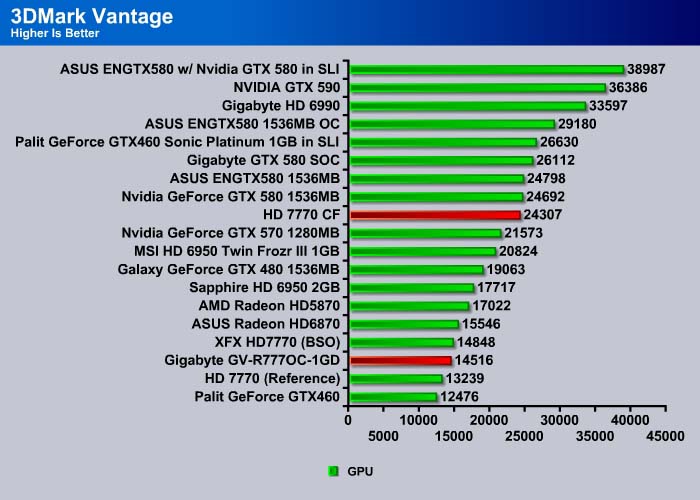

The Gigabyte’s HD 7770 performs just a tad under the XFX’s HD 7770 in the overall score but it actually yields 203 more points (1%) higher in the GPU test. With the two cards differ by only 25Hz in clockspeed, we do not expect much difference in terms of performance. Still, it is obvious that the factory overclocked card is substantially (~20%) faster than the reference card.
Pairing up two HD 7770 yields performance close to the GTX 580.
3DMARK 11
“3DMark 11 is the latest version of the world’s most popular benchmark for measuring the graphics performance of gaming PCs. Designed for testing DirectX 11 hardware running on Windows 7 and Windows Vista the benchmark includes six all new benchmark tests that make extensive use of all the new features in DirectX 11 including tessellation, compute shaders and multi-threading. After running the tests 3DMark gives your system a score with larger numbers indicating better performance. Trusted by gamers worldwide to give accurate and unbiased results, 3DMark 11 is the best way to test DirectX 11 under game-like loads.”
Like what we saw with 3DMark Vantage, 3DMark 11 shows a similar result.The Gigabyte HD 7770 is just a tad slower than the XFX card but is 5% (Extreme) to 8% (Performance) faster than the reference clocked card. Once again, we can see that two HD 7770’s in CrossFire are faster than the HD 6970, and are able to edge out the GTX 580 in the Extreme benchmark.
CRYSIS WARHEAD
Crysis Warhead is the much anticipated standalone expansion to Crysis, featuring an updated CryENGINE™ 2 with better optimization. It was one of the most anticipated titles of 2008. Crysis is no longer the most demanding games on the market. However, it is a favorite game for many gamers. The game is a very good benchmark to test to see how a video card will perform, especially under DirectX 10.

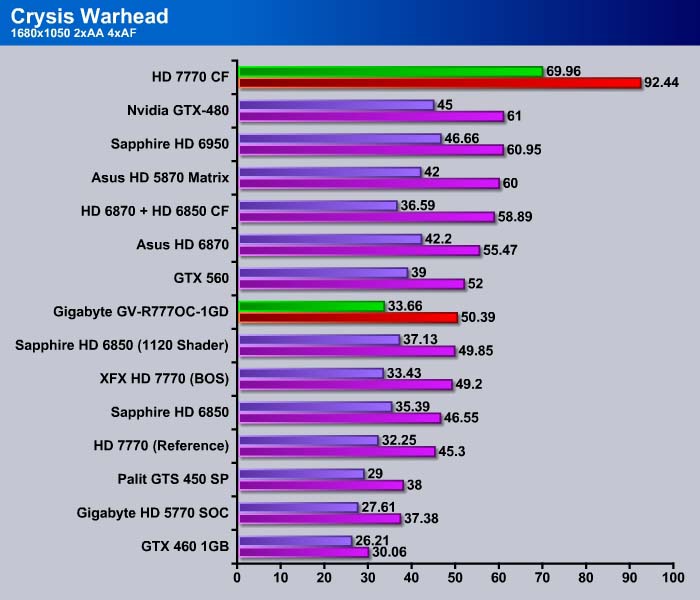
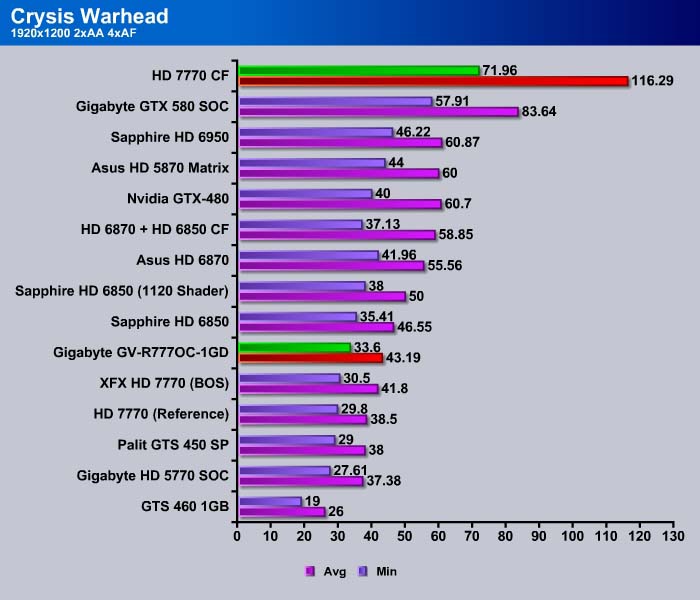
FAR CRY 2
Far Cry 2, released in October 2008 by Ubisoft, was one of the most anticipated titles of the year. It’s an engaging state-of-the-art First Person Shooter set in an un-named African country. Caught between two rival factions, you’re sent to take out “The Jackal”. Far Cry2 ships with a full featured benchmark utility and it is one of the most well designed, well thought out game benchmarks we’ve ever seen. One big difference between this benchmark and others is that it leaves the game’s AI (Artificial Intelligence ) running while the benchmark is being performed.
A similar result is seen with the Far Cry 2. The Gigabyte HD 7770 once again edges out the XFX card by 2 frames. It looks like the Gigabyte’s card is doing quite well in DX10 games.
Looking at the CrossFire performance, we see that two HD 7770’s actually outperform the HD 6870 and HD 6850 in CrossFire. While the HD 7770 may not always be faster than the HD 6850, it definitely performs better with CrossFire and scales better than the previous generation card.
METRO 2033
Metro 2033 is an action-oriented video game blending survival horror and first-person shooter elements. The game is based on the novel Metro 2033 by Russian author Dmitry Glukhovsky. It was developed by 4A Games in Ukraine and released in March 2010 for the Xbox 360 and Microsoft Windows. In March 2009, 4A Games announced a partnership with Glukhovsky to collaborate on the game. The game was announced a few months later at the 2009 Games Convention in Leipzig; a first trailer came along with the announcement. When the game was announced, it had the subtitle “The Last Refuge,” but this subtitle is no longer being used.
Metro 2033 is a shader intensive game and s capable of utilizing the new architecture design on the HD 7770. Thus, the HD 7770 performs much better. In fact, the HD 7770 is able to edge out not only the HD 6850 but also the HD 6870 at 1680×1050 resolution. At higher resolutions, the HD 7770 actually lost the battle to the GTX 550 Ti but the overclocked XFX card was able to tie the performance.
UNIGINE HEAVEN 2.5
Unigine Heaven is a benchmark program based on Unigine Corp’s latest engine, Unigine. The engine features DirectX 11, Hardware tessellation, DirectCompute, and Shader Model 5.0. All of these new technologies combined with the ability to run each card through the same exact test means this benchmark should be in our arsenal for a long time.
The HD 7770 performs somewhat poorly here. It is slower than the GTX 460 which is a year old, but the XFX card is able to edge out the GTX 460 by 5%.
S.T.A.L.K.E.R.: CALL OF PRIPYAT
Call of Pripyat is the latest addition to the S.T.A.L.K.E.R. franchise. S.T.A.L.K.E.R. has long been considered the thinking man’s shooter, because it gives the player many different ways of completing the objectives. The game includes new advanced DirectX 11 effects as well as the continuation of the story from the previous games.

S.T.A.L.K.E.R. is another test that puts the HD 7770 faster than the HD 6850. The new architecture really has an advantage when it comes to shader intensive applications.
Lost Planet 2
The reference clocked HD 7770 again lost to the GTX 460. However, the XFX card not only outperformed the GTX 460, it also edged out the HD 6870.
OVERCLOCKING
Overclocking is important to everyone, regardless of what they plan to do with a computer. Nearly all enthusiasts end up overclocking a computer at one point or another so it is always good to know what kind of performance each piece of hardware can achieve.
Since the Gigabyte card is already factory overclocked to 1100MHz and 1250 MHz (core/memory) from the reference speed of 1000MHz and 1125MHz (core/memory), we do not expect to be able to push it too far. We were able to overclock the card to 1155MHz core and 1350 memory.
The 3DMark11 score comes out to a gain of about 5% over the card’s stock speed. Our previous overclocking with the HD 7770 hits a similar clockspeed, so we are certain that we are not being limited by the cooling performance of the card, but rather by the computational limit of the chip itself. Overall, we would say that most HD 7770 should be able to overclock about 15% from the 1GHz reference speed without much issue.
Power Consumption
The power consumption was tested while running Furmark and with the AMD PowerTune set to 20%. The maximum power used during an extended time period test is what was used for the load values and the idle values were recorded after booting up the computer into Windows for at least 15 minutes.
Idle, the Gigabyte card consumes 2 watts more than the XFX card. However, under load, the card consumes 14 watts fewer than the XFX card. It looks like Gigabyte’s design and technology paid off handsomely here. This is definitely one of the more power-efficient cards available. The second card adds about 85 more watts of power. Notice that the power consumption is about half of what is needed for the HD 6850+HD 6870 combination and is much lower than a single HD 6850.
Temperature
The temperature was tested while running Furmark and with the AMD PowerTune set to 20%. The maximum temperature recorded during an extended time period test is what was used for the load values and the idle values were recorded after booting up the computer into Windows for at least 15 minutes.
Not only is the power consumption great on this card, the temperature is also superb. The card is cooler than the XFX card we had reviewed, under both idle and load. Lately, Gigabyte’s cards have been one of the cards with lowest load temperatures.
Noise-level
There is nothing worse than when a graphic card runs cool at the expensive of the noise level. Luckily, this is not the case with the Gigabyte HD 7770 OC. The card runs very quietly. Under load with Furmark, the fan runs at 40% (~1166RPM), pretty impressive for a factory overclocked card.
conclusion
Based on 28nm fab process, the HD 7770 is certainly a good mid-range card that runs games well at 1920×1080 resolution. No matter which manufacturer users ended up buying the card from, the performance difference will be small, even with a factory overclock. Based on what we have seen, most factory overclocked cards will run about 10% faster than the reference speed, which translates to 5~10% gain in games. In fact, if the money difference is not that great, buying a factory overclocked HD 7770 is definitely worth it as the extra overclocking puts the card’s overall performance equal or better than the HD 6850.
In dual configuration mode, the HD 7770 scales quite well. Depending on the games, we get about a 70~100% gain in performance with the second card. This puts the cards faster than the GTX 480 and close to the GTX 580. The fact that this card can get such great performance while consuming 50 watts fewer is quite nice. In addition, dual HD 7770 definitely outperforms a single HD 6850 while running much quieter and with lower power consumption.
The Gigabyte HD 7770 OC meets that perfect combination for a midrange card with its factory overclocking and price. Retailed at $159.99 on Newegg, the card is the cheapest overclocked HD 7770 available. In fact, it is even cheaper than some of the cards at the reference speed. This makes the Gigabyte HD 7770 OC the card to buy if you are looking for a midrange card. The slightly shorter length is also nice for small form factor PC’s.
| OUR VERDICT: Gigabyte HD 7770 OC | ||||||||||||||||||
|
||||||||||||||||||
| Summary: The Gigabyte HD 7770 OC is certainly worth considering if you are looking for a midrange card with good performance, low power consumption, and quiet operation. For its great value, the Gigabyte HD 7770 OC earns the Bjorn3D Seal of Approval. |
 Bjorn3D.com Bjorn3d.com – Satisfying Your Daily Tech Cravings Since 1996
Bjorn3D.com Bjorn3d.com – Satisfying Your Daily Tech Cravings Since 1996











